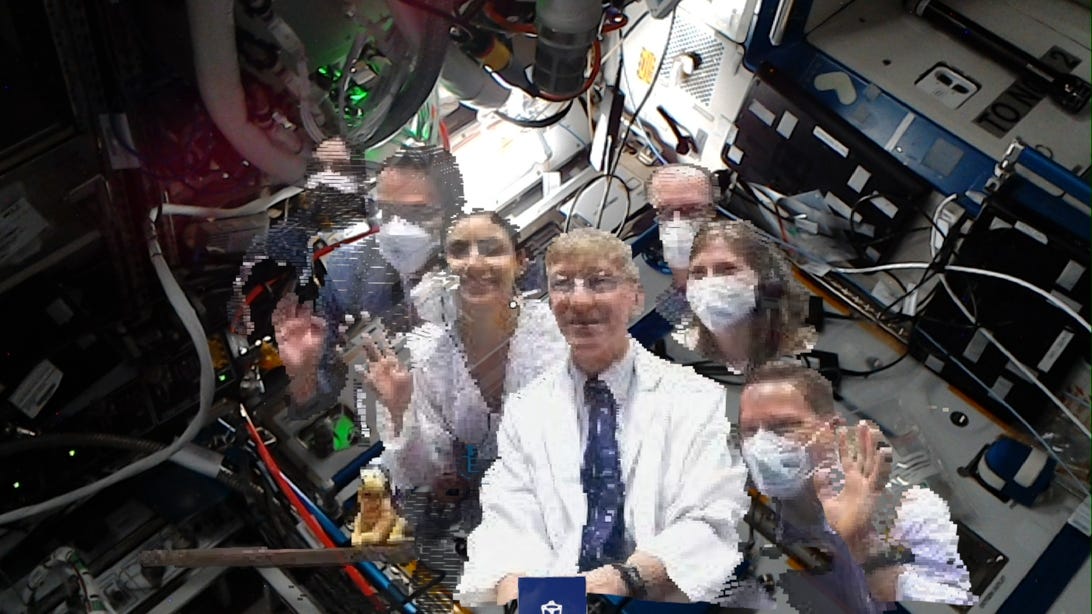

NASA flight surgeon Dr. Josef Schmid offers an area greeting Oct. 8, 2021, as he’s holoported directly to the World House Station.
ESA (Ecu House Company) astronaut Thomas Pesquet
I’ve a brand new noun in your vocabulary: Holoportation.
It is an amalgam of “hologram” and “teleportation,” and despite the fact that it should appear find it irresistible, it is not only a area of interest Sci-Fi time period buried someplace in Isaac Asimov novels and Big name Trek episodes.
In October, NASA used this mind-boggling, futuristic mechanism to deliver NASA flight surgeon Dr. Josef Schmid onto the World House Station whilst he was once safely planted on our planet. No rockets essential.
Schmid was once joined in this transdimensional adventure by means of Fernando De Los angeles Pena Llaca, the CEO of AEXA Aerospace, a company that helped broaden the holoportation apparatus, and a couple of different staff participants.
“This is a brand-new means of human exploration the place our human entity is in a position to trip off the planet,” Schmid mentioned in a commentary. “Our bodily frame isn’t there, however our human entity completely is there.”

Holoportation staff participants are observed projected just about at the World House Station, Oct. 8, 2021. From left are Andrew Madrid, Dr. Fernando De Los angeles Pena Llaca, RIhab Sadik, Dr. Joe Schmid, Kevin Bryant, Mackenzie Hoffman, Wes Tarkington.
ESA (Ecu House Company) astronaut Thomas Pesquet
Even though just about implausible, holoportation is not a wholly new generation. Microsoft got here up with the speculation a number of years in the past, however with the principle aim of revolutionizing sectors like promoting, terrestrial sanatorium care and schooling and has since been ceaselessly growing the idea that. However NASA’s fresh undertaking took the feat to the following stage.
That is the primary time such digital transportation has effectively introduced folks past planet Earth.
Here is how the entirety went down.
Mainly, top quality 3-d fashions of the holoporters had been advanced, digitally compressed, transmitted and reconstructed within the spaceborne lab — all in genuine time.
In the meantime, a blended truth show aboard the ISS, specifically Microsoft’s HoloLens, allowed each the holoporters and astronauts to look, pay attention and engage with one some other as despite the fact that they had been in the similar bodily area. Astronaut Thomas Pesquet, as an example, had a two-way dialog with Schmid and De Los angeles Pena proper in the course of the ISS in spite of being miles upon miles clear of the holoporters.
The trio even holographically shook palms.
“We will use this for our non-public scientific meetings, non-public psychiatric meetings, non-public circle of relatives meetings and to deliver VIPs onto the distance station to seek advice from with astronauts,” NASA mentioned in a commentary.

Microsoft’s HoloLens 2 from final 12 months.
Scott Stein/CNET
And, going ahead, the company intends to scale-up its device by means of including an augmented truth serve as, which might give holoporters the method to truly transfer across the area station and apply issues as despite the fact that they are actually there. The entirety however the bodily contact, you may say.
This might lend a hand with extraterrestrial telemedicine for astronauts, ISS construction initiatives or even a great deal receive advantages long run deep area exploration. The latter bit is vital, as a result of usual radio communications generally enjoy as much as 20-minute delays when chatting with programs means (means) out into the void. With holoportation, holoporters may simply keep onboard for real-time conversation.
“It’s not relevant that the distance station is touring 17,500 miles in line with hour and in consistent movement in orbit 250 miles above Earth,” Schmid mentioned. “The astronaut can come again 3 mins or 3 weeks later, and with the device working, we can be there in that spot, residing at the area station.”
Plus, NASA says this will have direct programs on Earth, like for researchers running in excessive environments or army operation experts.
“Believe you’ll deliver the most efficient teacher or the true dressmaker of a in particular advanced generation proper beside you anyplace you may well be running on it,” Schmid mentioned. “You’ll paintings at the tool in combination, similar to two of the most efficient surgeons running all over an operation. This might put everybody at relaxation realizing the most efficient staff is operating in combination on a important piece of {hardware}.”
Get the CNET Science newsletter
Unlock the biggest mysteries of our planet and beyond with the CNET Science newsletter. Delivered Mondays.
